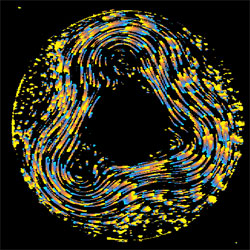Mini-Atmospheres Synch-Up in the Lab
Meteorologists believe that changes in one location, such as the El Niño Pacific temperature variations, can generate changes somewhere else, such as storms in the eastern US. Now a team has demonstrated in the lab that weakly linked chaotic weather systems can synchronize. In the 21 May Physical Review Letters, they report that “cyclones” in two rotating tanks of fluid representing two regions of the atmosphere can fluctuate together, even when the flows are partially chaotic. The results could help researchers build better models to predict local weather and global climate change.
Researchers have long suspected that certain recurring weather patterns, such as a travelling tropical rainfall called the Madden-Julian oscillation or the quasi-periodic weather event called El Niño, were connected to weather events on other parts of the globe. These links were typically explained by ever-growing waves propagating through the atmosphere, as in the so-called butterfly effect. Other complex physical systems, like electronic circuits, lasers, and the human brain, can also generate two chaotic signals at different locations that manage to synchronize through weak links, a phenomenon called teleconnection. But no one has demonstrated teleconnections in a chaotic fluid system like the atmosphere.
Several earlier experiments modeled atmospheres in the lab using a rotating, cylindrical tank filled with a mixture of glycerol and water. The liquid fills the space between the outer wall and an inner cylinder. The outer cylinder is heated, and the inner cylinder is cooled, mimicking temperature differences between the tropics and the pole.
These mini-atmospheres are accurate enough to test aspects of weather forecasting models, but they only capture the flow in either the northern or southern hemisphere. To investigate how fluctuations in one hemisphere influence weather in the other, Alfonso Castrejón-Pita and Peter Read of the University of Oxford in England set up two such tanks. The temperatures were maintained with water flowing through hoses that coil around the cylinders. The team connected the output of the hose from the warm surface of one tank (the “master”) to the input of the warm water hose of the other tank (the “slave”), simulating tropical winds flowing across the equator. Although the temperatures were regulated to within less than five hundredths of a degree, even smaller fluctuations in temperature could be transmitted from master to slave.
The researchers controlled the fluid flow in the master tank by varying the rotation speed and the temperature difference between the hot and cold surfaces. They set up a chain of several cyclones around the ring with alternating rotational directions, analogous to the so-called zonal index cycle on Earth. At first the researchers held the fluid flow in this regular pattern; then they slowed the rotation to encourage chaotic perturbations in the flow. In both cases, the second tank quickly developed similar patterns.
To test the link quantitatively, the team analyzed temperature fluctuations recorded from a ring of thermometers in each tank. They came up with a mathematical scheme to measure the degree of synchronization of two signals that were not perfectly periodic nor completely random. Even when the water temperature leaving the master tank fluctuated by as little as two hundredths of a degree, the chaotic flows appeared coupled. “The oscillations of the cyclones, which can be chaotic in time, seem to link up really well with what the cyclones developing in the other system are doing,” Castrejón-Pita says. This shows that meteorological information can be passed around the globe through heat transfer alone, with no need for the butterfly effect, he says.
The researchers are now applying their mathematical techniques to real weather data and have found that the oscillations of tropical rainfall and the cycle of mid-latitude cyclones are sometimes synchronized. Castrejón-Pita hopes the new work will convince more climate scientists to modify their models to include synchronization.
Jürgen Kurths of the University of Potsdam in Germany, who has studied teleconnections in the brain, was surprised that the paper shows such clear synchronization in such a complicated system. “This is a very well-performed experiment,” he says. “Our neural data are never so nice, I can tell you.”
–Lisa Grossman
Lisa Grossman is a freelance science writer.





